|
Fabergé Eggs
Answer
to Name
This Famous Antique Game - September 2013
|
 |
Ted Carlton of Utah, Teresa P. Bland and Robert Bernier of Beaverton, Ontario, Canada, correctly identified the famous antique as a Fabergé Egg.
|
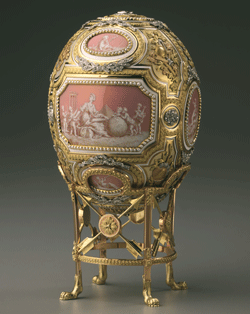
|
The Catherine The Great Egg, presented in 1914, now displayed in the Hillwood Museum, Washington, D.C. Presented by Nicholas to his mother, pink enamel panels featured miniature scenes of the arts and sciences, honoring its namesake who was a patron of both. The surprise has been lost, but it was a miniature of Catherine the Great being carried in a mechanical sedan chair by two Blackamoors. The egg is made of diamonds, pearls, gold, opalescent enamel, opaque enamel, silver and platinum.
(Photo, courtesy Hillwood Estate, Museum and Gardens.)
|
Fabergé Eggs are considered to be some of the most important objets de vertu ever created. Fifty Imperial Eggs were created; of those, 42 still survive today. About 15 more eggs were created for other clients of the House of Fabergé. Currently, Fabergé Eggs are owned by:
*The Kremlin Armory in Moscow, ten eggs;
*Viktor Vekselberg, Russian business magnate, nine eggs purchased from the Forbes Family;
*Queen Elizabeth II, three eggs;
*Prince Albert II of Monaco, son of Prince Rainier and Princess Grace Kelly, one egg, the Blue Serpent Clock Egg inherited from and beloved by his mother (the only egg with a clock in it).
*One, two or three eggs are owned by or displayed in museums, foundations and individuals in Cleveland, Washington, D.C., Baltimore, Switzerland, Germany and Qatar. One museum, the Virginia Museum of Fine Arts in Richmond, possesses five Fabergé Eggs.
|
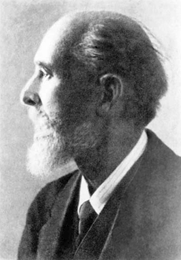
|
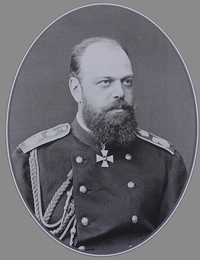
|
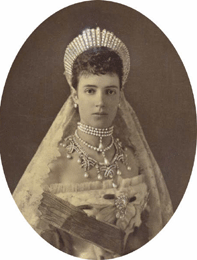
|
|
Peter Carl Fabergé
|
Tsar Alexander III
|
Maria Fedorovna, wife of Alexander.
|
The five people historically involved with the most famous Easter eggs in the world are: Peter Carl Fabergé (aka, Karl Gustavovich Fabergé); Tsar Alexander III; his wife Maria Fedorovna (aka, Princess Dagmar of Denmark); their son Nicholas II, who became tsar when his father died of nephritis at the age of 49; Nicholas’wife Alexandra Feodorovna (aka, Viktoria Alix Helena Louise Beatrice of Hesse, a German princess and granddaughter of Queen Victoria; she was given the name of Alexandra after she converted to the Russian Orthodox faith so she could marry Nicholas II).
|
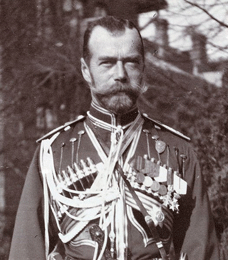
|
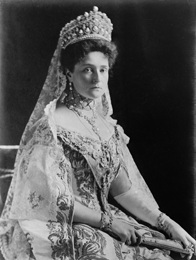
|
|
|
Tsar Nicholas II, son of Tsar Alexander III
|
Feodorovna, wife of Nicholas.
|
|
As is well known, Alexander III commissioned Fabergé to create the Easter eggs for his wife beginning in 1885. Each had a surprise inside, and each required a year to create. Over the years, Fabergé employed artists, jewelers, fine metal workers and Swiss clockwork makers to create these unique works of art. Following Alexander’s death, Tsar Nicholas, at the age of 26, continued presenting Easter eggs, commissioning Fabergé to create them for his wife and his mother.
Fabergé Eggs were certainly unparalleled in his day and have very few peers today. As an example, the Imperial Coronation Egg presented in 1897 to honor the 1894 coronation of Tsar Nicholas II was made of gold with yellow enamel. The surprise inside was a precise replica of the coronation carriage—but it was less than four inches long. The outstanding carriage featured a body of red enamel, gold, diamonds, and platinum wheels that spun. The doors opened to blue enamel upholstery inside with a step that unfolded. The vehicle was correct in design down to the carriage springs.
It is reported that Fabergé’s enameling was of such superior quality that it cannot be matched today. His trade secrets and processes were hidden away and lost to history.
With his work for the royal Romanov Family, Fabergé became world famous, employing dozens of the finest craftsmen. All of his work was not only distinct; it was also unique. No piece was made more than once, and Fabergé stood by this guarantee by reportedly destroying any piece that did not sell by the end of the year.
|
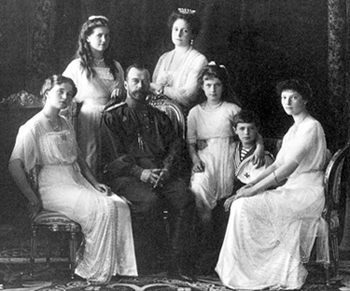
|
The execution of Tsar Nicholas and his family ended the 300-year rule of Russia by the Romanov Dynasty. (L-r): Olga, Maria, Nicholas II, Alexandra Fyodorovna, Anastasia, Alexi, and Tatiana.
|
After the Russian Revolution, only Maria, the wife of the late Tsar Alexander, avoided the Bolshevik firing squad which assassinated Nicholas, Alexandra, their four daughters, one son, and four servants who chose to remain with them. One of the items that Maria escaped with was a Fabergé Egg given to her by Nicholas in 1916, the Order of St. George Egg. It commemorated Nicholas receiving the Order of St. George medal, which was instituted by Catherine the Great in 1796 and was given to military officers whose service during war resulted in the complete defeat of the enemy.
The Order of St. George Egg was one of nine purchased by Viktor Vekselberg from the Forbes Family. The total price of the collection’s sale was not reported, but Forbes Magazine estimated the value of the nine eggs at $80 million to $120 million, the Coronation Egg alone being worth $18 million to $24 million.1
|
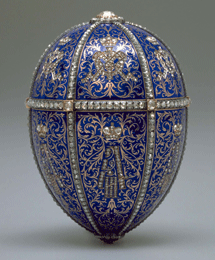
|
In 1885, Alexander III initiated the custom of presenting his wife, Maria Fedorovna, with a Fabergé egg each Easter. Beginning with this particular egg, Alexander III's son, Nicholas II, continued the family tradition each Easter by giving an egg to both his mother, Maria, and his wife, Alexandra. Rows of diamonds divide the egg into twelve panels. The crowned ciphers of Alexander III and Maria Fedorovna, set in diamonds, provide a simple yet elegant decoration against the dark blue enamel. Only under high magnification is it possible to notice the champlevé enamel technique. Areas for the enamel were carved out of the gold, leaving the thin red-gold ribs that form the foliate design. To the naked eye, it appears that the gold design was painted on the ovoid surface.
The Twelve Monogram Egg is also known as the Twelve-Panel Egg. It was created by Workmaster Mikhail Perkhin for Fabergé in 1895, and it is 3 1/8 inches high by 2 3/16 inches wide. (Photo, courtesy Hillwood Estate, Museum and Gardens.)
|
Carl Fabergé left Russia during the Revolution in 1918; the Bolsheviks seized and nationalized his company and its assets. He died in Switzerland a few years later.
After nationalization of the House of Fabergé, Vladimir Lenin ordered the eggs taken to the Kremlin Armory. Later, he also ordered several of them be put in the hands of his friend Armand Hammer, owner of Occidental Petroleum, to sell them to support his cash-strapped government.2 This is how Faberge Eggs made their way into the collections of Americans, including Malcolm Forbes.
|
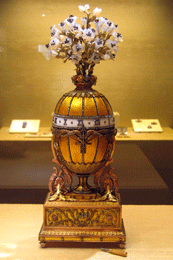
|
The Bouquet of Lilies Clock Fabergé Egg, 1899, Kremlin Armory. Presented to Tsarina Alexandra, the flowers were of onyx, gold and diamonds, and the wind-up clock’s hours were marked by an arrow of diamonds. The surprise, now lost, was a ruby pendant with diamonds. (Photo: Shakko.)
|
To see Faberge Eggs without traveling to Moscow or London, visit the Hillwood Museum in Washington, D.C., the former home of collector Marjorie Merriweather Post.3 Two are on exhibit: the Catherine the Great Egg and the Twelve Monograms Egg. Those belonging to the Virginia Museum of Fine Arts are on tour and are not due back in Richmond until 2015.
---------------------------------------
1
Forbes.com, “Russian Tycoon Buys Forbes Faberge Eggs,” Feb. 2, 2004.
2 PBS.org, “Faberge Eggs…The Fate of the Eggs.” http://www.pbs.org/treasuresoftheworld/faberge/flevel_1/f7_fate_of_eggs.html.
3 Marjorie Merriweather Post (1887-1973) inherited the Postum Cereal Company (Post Cereals) at the age of 27 after the passing of her father C.W. Post. After acquiring several other companies, it later became General Foods. Her third husband Joseph E. Davies served as a second ambassador to Russian in 1937 and 1938. It was then that they began collecting art and treasures. Her fortune totaled $250 million.
|